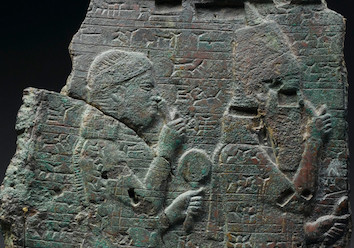Neo-Assyrian Period (721–612 BC)

AO 20185, a fragment of a bronze relief depicting Naqīʾa and an Assyrian king. Photo credit: Collection of Antiquités Orientales of the Musée du Louvre.
Although Tiglath-pileser III (r. 744–727 BC) and his son and immediate successor Shalmaneser V (r. 726–722 BC) ruled over Babylonia from 728–722 BC, it is not until the later part of Sargon II's reign (710–705 BC) that Assyrian building activities were sponsored in Babylonian cities. Large-scale Assyrian construction projects continued to take place until the death of Aššur-etel-ilāni (r. 630–627 BC), Ashurbanipal's son and first successor. After that time, Assyria was not in a position to sponsor building in Babylonia since it was under the control of Nabopolassar (r. 625–605 BC), a self-described "son of a nobody" from Uruk who became king of Babylon in late 626 BC. Five of Assyria's last eight rulers are known to have sponsored building in Babylonia. Click on the links below or in the left-hand menu to access information about these kings' building activities.
- Sargon II (r. 721–705 BC)
- Sennacherib (r. 704–681 BC)
- Esarhaddon (r. 680–669 BC)
- Ashurbanipal (r. 668–ca. 631 BC)
- Aššur-etel-ilāni (r. 630–627 BC)
- Sîn-šuma-līšir (r. 626 BC)
- Sîn-šarra-iškun (r. 626–612 BC)
- Aššur-uballiṭ II (r. 611–609 BC)
While Ashurbanipal and Aššur-etel-ilāni were kings of Assyria, Šamaš-šuma-ukīn (r. 667–648 BC), Ashurbanipal's older brother, and Kandalānu (647–627), a still largely-shadowy individual, were the king's of Babylon. The former is known to have sponsored building projects and, thus, his activities are included in this section of BTMAo.
Jamie Novotny
Jamie Novotny, 'Neo-Assyrian Period (721–612 BC)', Babylonian Temples and Monumental Architecture online (BTMAo), The BTMAo Project, a sub-project of MOCCI, [http://oracc.org/btmao/StructuresbyBuilder/Neo-AssyrianPeriod/]